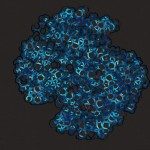Link to Pubmed [PMID] – 24134781
Mol. Microbiol. 2013 Dec;90(6):1309-23
Signal transduction ATPases with numerous domains (STAND) are widespread proteins, whose activation involves inducer-dependent conversion of resting ADP-bound monomers into active ATP-bound multimers. This process notably comprises opening of the nucleotide-binding oligomerization domain (NOD), nucleotide exchange and NOD-mediated multimerization. How inducer binding to the sensor domain, whose structure is not conserved throughout the STAND family, causes protein activation remains unclear. We used MalT, an Escherichia coli transcription factor, as a STAND model system, to address this question by dissecting the signalling pathway in vitro. We have found that inducer binding to the sensor is the first step of the activation pathway. It both triggers opening of the NOD and makes the MalT multimer competent for binding promoter MalT sites via its DNA-binding domains. Based on available data, we proposed that inducer trigger of NOD opening is a conserved STAND feature, irrespective of the sensor structure. As discussed, an additional role for the inducer, as found for MalT, might pertain to other types of STANDs.


